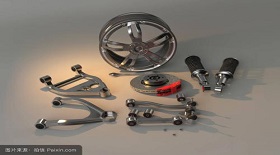The design of brake
From the point of view of economy and practicality, automobile designers usually adopt the mixed form of front wheel disc brake and rear wheel drum brake. In the braking process of a four-wheeled car, due to inertia, the load on the front wheel usually accounts for 70-80% of the total load of the car, so the load on the front wheel is larger than that on the rear wheel. In order to save costs, car manufacturers use front wheel brake and rear wheel drum brake. Four-wheel disc brake medium and high-grade cars, the use of front-wheel ventilated disc brake is to better heat dissipation, as for rear-wheel non-ventilated disc is also a cost reason. After all, the manufacturing process of ventilating disc is much more complicated and the price is relatively expensive. With the development of material science and the reduction of cost, disc brake is gradually replacing drum brake in the field of car.
In general, the brake applies braking torque to the rotating components through the fixed components, which reduces the rotating angular speed of the latter. At the same time, it relies on the adhesion between the wheel and the ground to generate the braking power of the road to the wheel to decelerate the car. All brakes that produce braking torque by friction between fixed and rotating components are called friction brakes. The friction brake used by automobiles can be divided into two categories: drum type and disk type.
Rotating elements fixed on the wheel or half shaft, so brake torque acting directly on the two sides of the wheel brake is called the wheel brake. The rotating element is fixed on the transmission shaft of the transmission system, and the brake torque is redistributed to the wheels on both sides of the drive axle, which is called the central brake.
Welcome to the Mechanical parts Exhibition.



